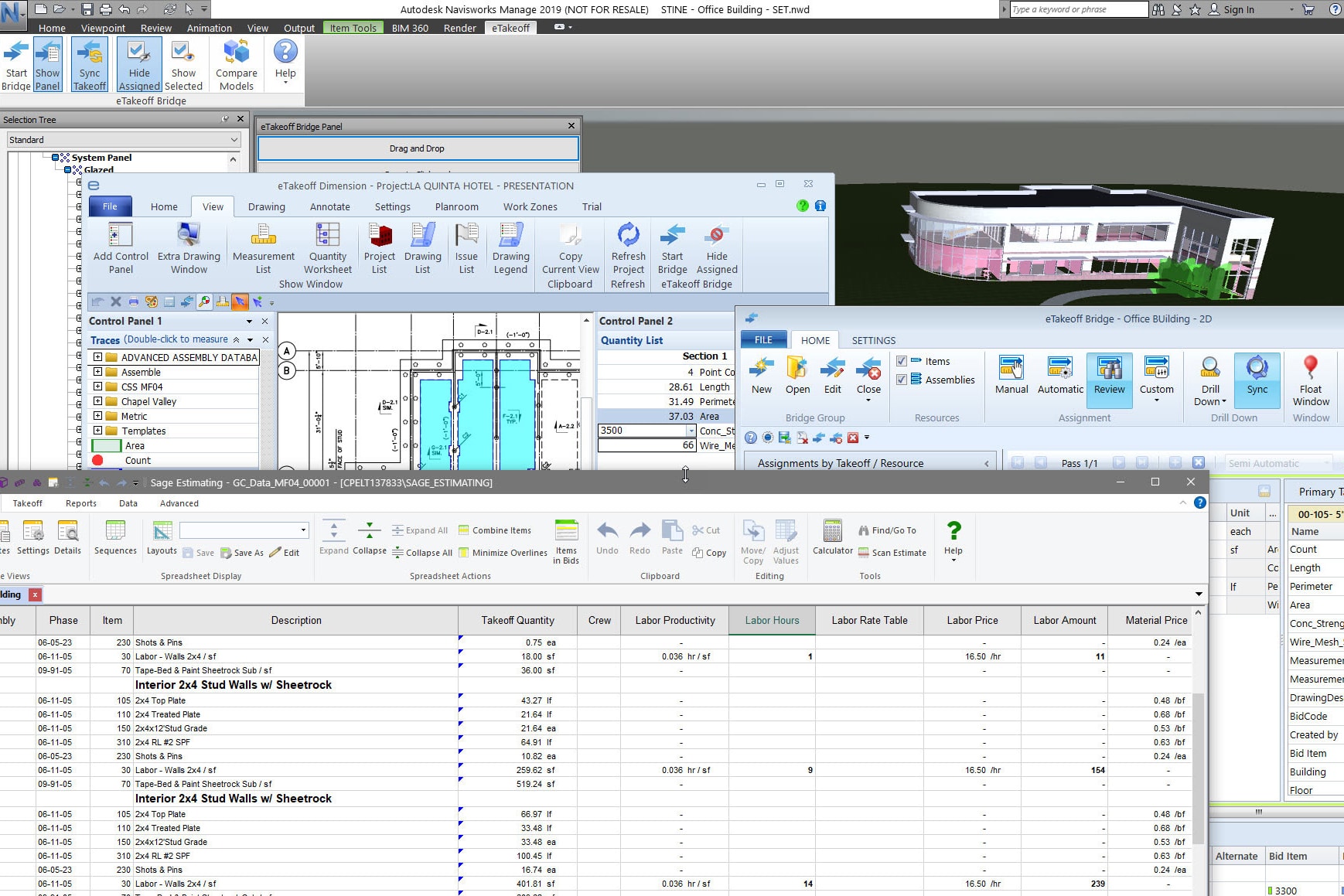Today’s contractors are looking for better ways to collaborate with owners, architects, engineers, and other project stakeholders to find the most cost-effective way to complete complex projects and build smart buildings. They are confronted with an exceedingly risky climate as they face a qualified worker shortage, economic recession, and global pandemic in an already fast-paced, high-risk, slim-margin industry.
More businesses are turning to technology to help their firms survive these challenging times. Building information modeling (BIM) is one technology solution that has gained popularity in recent years.
Building Information Modeling: The Catalyst for Better Building
On the surface, BIM is a digital representation that communicates the physical and functional characteristics of a project—but it provides much more than 3D modeling software. BIM involves a business process and provides collaborative tools to facilitate positive results. It’s also a shared resource that establishes a basis for decision-making throughout a project’s life cycle and assists in problem solving, solution simulations, and impact analysis.
BIM can help eliminate a range of issues that plague contractors, such as cost, schedule, constructability, and rework. It also facilitates collaboration with your entire project team so you can do more work faster.
BIM technologies have been around in some form since the 1970s and are widely used in architecture, engineering, and construction, but it’s only in the past few years that it’s become easier for estimators to build estimates using model and 2D content. The 2020 Construction Hiring and Business Outlook Survey conducted by the Associated General Contractors of America and Sage found that 18% of respondents expected an increase in the number of projects that involve BIM in 2020, while 39% expected to have about the same number of BIM projects. Those surveyed are primarily using it for clash detection (25%), constructability input into the design process (21%), construction means and methods (19%), and to visually communicate project scope to clients (18%).

Building Information Modeling in action. Photo courtesy of Sage
Understanding the Different Dimensions
BIM dimensions refer to levels of information and data entered into a 3D model using BIM software. 3D BIM is the intelligent, object-oriented design of a built asset. It enables you to visualize and inspect projects through realistic representations of elements. It is also helpful in detecting constructability issues and clashes. Overall you will be able to better communicate project scope to stakeholders.
4D BIM links 3D model components to timelines enabling you to determine appropriate resource scheduling. It also makes it easier to identify potential bottlenecks, develop phasing plans, and track and verify milestones.
5D builds upon the capabilities of 3D and 4D BIM and also takes costs into consideration. You can bring together design and scheduling with costing and provide project teams with detailed project cost-risk analyses. Users can link the BIM model so a change in the design reflects in the budget, while also creating design-schedule-cost what-if scenarios so they are prepared for a number of situations.
6D and 7D BIM have recently gained traction, addressing energy consumption and facility management throughout the life cycle of a building, respectively. I’ll discuss those in greater detail as I look at how BIM impacts green building practices.
The Power of Building Information Modeling
Adopting BIM to create estimates gives you three distinct advantages: visualization, speed, and collaboration.
Visualization
A 3D building model provides you with an interactive, information-rich representation that makes it easy to see individual elements and how they relate to each other. It also contextualizes the complexity of a project and helps you identify potential risks.
Faster Takeoffs, More Analysis
Every object in your model can contain dimensional information, like length and width, so you can build estimates faster and more accurately. BIM tools integrated with estimating software also accelerates the development of quantities and variances whenever changes occur on a project.
Collaboration
The BIM process enables collaboration, so you can provide early and accurate cost feedback to both your design team and your customers.
Additionally, using BIM technology can help you to:
- Enhance how estimating input is captured and information is exchanged.
- Innovate by calculating the optimum design-cost scenario.
- Reduce unbudgeted changes on projects.
- Identify incongruences before you have to pay for them.
- Increase quality control and design coordination to decrease remedial work.
- Impact the design process for higher quality project delivery.
Reducing Common Roadblocks
Designers, estimators, and the rest of the building team are constantly trying to provide the most useful information to each other throughout the lifecycle of a project. However, if a designer’s models are missing any information an estimator needs, they would traditionally have to fill in any missing information with 2D plans. But BIM technology makes it possible to easily create estimates with both 2D and 3D content, helping project teams overcome the challenge of incomplete models.
BIM also helps streamline often tedious and time-consuming tasks. It gives you access to model information that you can put into your estimate quickly, so you can spend less time on model takeoff. For example, it allows you to link construction objects from a model directly to assemblies, like walls, in an estimating database. This provides you with time-saving shortcuts, such as taking off all 3-5/8 metal stud walls in a single step.
As a project progresses, there are undoubtedly questions around how design revisions, updates, or scenarios impact cost. Changes can hamper a project’s momentum, but BIM can help accelerate the decision-making process by providing cost-analysis answers quickly and making it easy to update the estimate any time there’s a design change.

Photo courtesy of Sage
BIM and the Construction Ecosystem
The construction ecosystem is quite large. It requires project managers, building owners, subcontractors, architects, engineers, material suppliers—and thousands of transactions between them—to complete a project. When you consider the entire life cycle of a building, the ecosystem expands even further.
The construction industry lags behind other industries in the efficiency of our ecosystem. At the heart of the issue is how we share data. When you think of the sheer number of documents involved during the building process, it can be overwhelming. BIM technology is one way you can more efficiently and accurately share and repurpose data to improve project delivery.
A building’s initial design and construction is a relatively small portion of its total lifetime cost. The majority of the cost occurs after the building is complete, when hundreds of companies interface to manage, maintain, retrofit and renovate a facility. BIM technology makes it easier to provide owners with detailed and updated “as-built” information that they can use to more cost-effectively maintain their buildings over time. Improving the ability to share data increases project productivity and, in turn, creates a more efficient construction ecosystem.
BIM’s Impact on Green Building
BIM technology supports sustainable building practices by reducing waste, managing water resources, and minimizing energy consumption. By allowing stakeholders to fully coordinate building components in 3D prior to the construction phase, it helps cut down on change orders and revisions, which can be costly and time-consuming.
BIM software also contains a clash detection component that automatically alerts teams of any potential conflicts or clashes in the design phase of a project. It can detect a hard clash, when two objects intersect or occupy the same area; a soft clash, when objects infringe on spatial constraints that are put into place to provide access or meet safety standards; or a workflow clash, when there are scheduling or delivery issues or other timeline conflicts. Being alerted to these potential issues before building has begun greatly reduces the need for re-work, and thus the excess waste that stems from it.
An EPA report estimated that 569 million tons of Construction and Demolition (C&D) debris were generated in the US in 2017, which is more than twice the amount of generated municipal solid waste. The greater accuracy in estimating materials that BIM delivers is a vital aspect of sustainable building.
Additionally, there’s the usage of 6D and 7D BIM, which factor long-term sustainability and facility management into the building process. 6D BIM helps make a building more sustainable and energy efficient. It looks beyond the upfront costs associated with building a project and estimates total energy consumption right at the start of a project. The information gathered in 6D also helps in supporting facility management in 7D BIM.
7D BIM optimizes asset and facility management throughout the life cycle of a project. It collates everything related to facility management at a single place within the building information model and tracks important asset data such as the state of a component, technical specifications, required maintenance schedule and technical reviews, manuals or applicable warranty periods. This ensures every project asset stays in the best shape, streamlines maintenance, and improves the quality of service from project inception all the way to the demolition of a structure.
BIM is Here to Stay
BIM is truly a powerhouse in the architecture, engineering, and construction space. With its ability to transform information into a meaningful, functional representation of all building elements, increase collaboration among building teams, and deliver more cost-effective and sustainable projects in less time, it’s no wonder more businesses are turning to BIM technology.
Is your business ready to implement BIM technology? Before you choose a BIM solution, identify and communicate the changes you anticipate in your current processes. Because BIM involves multiple parts of the construction ecosystem, it’s important to establish a process that encourages feedback, knowledge sharing, and ongoing collaboration. Proper training, awareness, and adaptability will help ensure a smooth deployment so you can start taking advantage of all the benefits BIM can offer from the efficiencies and cost savings it brings to a project to the impact it has on the environment.




